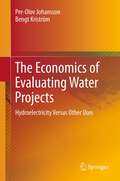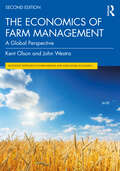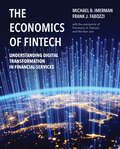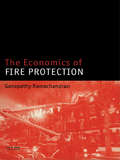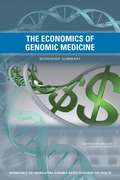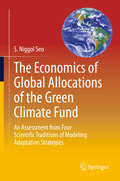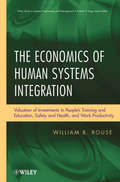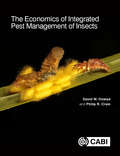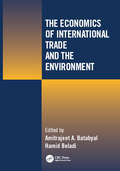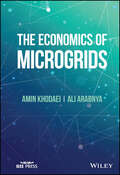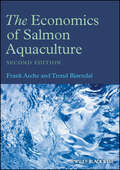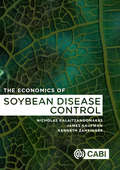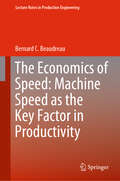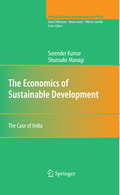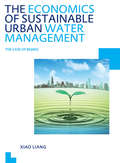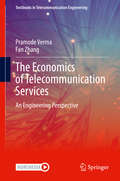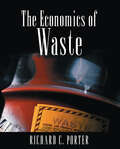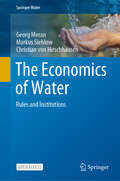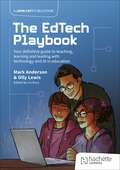- Table View
- List View
The Economics of Evaluating Water Projects: Hydroelectricity Versus Other Uses
by Per-Olov Johansson Bengt KriströmThis book presents research on a kind of water use conflicts that is becoming more and more common and important: How to best manage moving water in times of increasing demand for electricity as well as environmental services. How should decisions be made between water use for electricity generation or for environmental and recreational benefits? The authors develop a simple general equilibrium model of a small open economy which is used to derive a cost-benefit rule that can be used to assess projects that divert water from electricity generation to recreational and other uses (or vice versa). The cost-benefit rule is then applied to the specific case of a proposed change at a Swedish hydropower plant. The book provides a manual for the evaluation of river regulations which can easily be replicated in other studies.
The Economics of Farm Management: A Global Perspective (Routledge Textbooks in Environmental and Agricultural Economics)
by Kent Olson John WestraFuture farm managers need a range of tools and knowledge to run successful businesses, and this accessible textbook provides the required foundations from economics and management, applied to the farm context. In today’s world where farms are subject to ever-changing industrial, labor, demographic, and technological factors, this textbook provides a clear focus and methodology for business stability and growth. It covers core microeconomic and macroeconomic principles, plus the full range of management topics, from accounting and marketing to operations management and human resource management. It also covers family succession planning and farming mega-trends. This second edition has been updated with the latest data and literature, and gives deeper attention to sustainability and conservation. It also offers a broader range of examples, showcasing the diversity of farm types and farm sizes across the US and globally. Instructor materials are available as digital supplements. This textbook will be a valuable resource for courses in farm management, ranch management, agribusiness, and agricultural economics.
The Economics of FinTech: Understanding Digital Transformation in Financial Services
by Frank J. Fabozzi Michael ImermanA groundbreaking, comprehensive exploration of how FinTech innovation is reshaping finance.Technological innovation has shaped the role of finance since the introduction of the ATM in the 1960s, but never more consequentially than by the massive digital revolution in the financial services industry known as FinTech. The Economics of FinTech is a comprehensive introduction to this rapidly evolving and increasingly important domain, and a groundbreaking exploration of how FinTech is reshaping finance. Michael Imerman and Frank Fabozzi distill the dynamic developments of this multidisciplinary field into a cohesive, accessible guide that covers the economic underpinnings of FinTech innovation, framed within the established principles of financial intermediation, management theory, and data science. Coverage includes in-depth analysis of emerging technologies and innovations across various sectors of financial services as well as the entrepreneurial finance of FinTech such as funding, valuation, and startup management. The first book to examine the economic principles of FinTech innovation Comprehensive coverage of financial technologies across various sectors in financial services Ideal for undergraduate and graduate students as well as entrepreneurs, investors, and finance professionalsInstructor resources include solutions, slides, and case studies
The Economics of Fire Protection
by Ganapathy RamachandranThis important new book, the first of its kind in the fire safety field, discusses the economic problems faced by decision-makers in the areas of fire safety and fire precautions. The author considers the theoretical aspects of cost-benefit analysis and other relevant economic problems with practical applications to fire protection systems. Clear examples are included to illustrate these techniques in action. The work covers: * the performance and effectiveness of passive fire protection measures such as structural fire resistance and means of escape facilities, and active systems such as sprinklers and detectors * the importance of educating for better understanding and implementation of fire prevention through publicity campaigns and fire brigade operations * cost-benefit analysis of fire protection measures and their combinations, taking into account trade-offs between these measures. The book is essential reading for consultants and academics in construction management, economics and fire safety, as well as for insurance and risk management professionals.
The Economics of Genomic Medicine
by Institute of Medicine Steve Olson Board on Health Sciences Policy Adam C. Berger Roundtable on Translating Genomic-Based Research for HealthThe sequencing of the human genome and the identification of links between specific genetic variants and diseases have led to tremendous excitement over the potential of genomics to direct patient treatment toward more effective or less harmful interventions. Still, the use of whole genome sequencing challenges the traditional model of medical care where a test is ordered only when there is a clear indication for its use and a path for downstream clinical action is known. This has created a tension between experts who contend that using this information is premature and those who believe that having such information will empower health care providers and patients to make proactive decisions regarding lifestyle and treatment options. In addition, some stakeholders are concerned that genomic technologies will add costs to the health care system without providing commensurate benefits, and others think that health care costs could be reduced by identifying unnecessary or ineffective treatments. Economic models are frequently used to anticipate the costs and benefits of new health care technologies, policies, and regulations. Economic studies also have been used to examine much more specific issues, such as comparing the outcomes and cost effectiveness of two different drug treatments for the same condition. These kinds of analyses offer more than just predictions of future health care costs. They provide information that is valuable when implementing and using new technologies. Unfortunately, however, these economic assessments are often limited by a lack of data on which to base the examination. This particularly affects health economics, which includes many factors for which current methods are inadequate for assessing, such as personal utility, social utility, and patient preference. To understand better the health economic issues that may arise in the course of integrating genomic data into health care, the Roundtable on Translating Genomic-Based Research for Health hosted a workshop in Washington, DC, on July 17-18, 2012, that brought together economists, regulators, payers, biomedical researchers, patients, providers, and other stakeholders to discuss the many factors that may influence this implementation. The workshop was one of a series that the roundtable has held on this topic, but it was the first focused specifically on economic issues. The Economics of Genomic Medicine summarizes this workshop.
The Economics of Global Allocations of the Green Climate Fund: An Assessment from Four Scientific Traditions of Modeling Adaptation Strategies
by S. Niggol SeoThis book provides an incisive and economic assessment of the global warming adaptation policy and programs carved out by the United Nations Framework Convention on Climate Change, the Green Climate Fund (GCF), by relying on the four scientific traditions that have been advanced on the economics of adaptation to climate change in agricultural and natural resource enterprises. Substantially expanding and refocusing on the book Micro-behavioral Economics of Global Warming: Modeling Adaptation Strategies in Agricultural and Natural Resource Enterprises published by Springer in 2015, this book elucidates the theories and summarizes the empirical results and predictions from the four traditions of adaptation modelling: a microbehavioral economic model of adaptation, an agronomic-economic modelling, a statistical model of yield/productivity changes, and an ecosystem model of climate change impacts. The four modeling traditions are freshly analyzed and applied to the assessments of the 93+ GCF-funded projects and programs through the end of 2018.
The Economics of Groundwater Remediation and Protection (Integrative Studies in Water Management & Land Development)
by Ece Ozdemiroglu Paul E. HardistyEconomic literature is often too theoretical for engineers and policymakers to put into practical use, while scientific literature on the remediation of contaminated aquifers rarely considers costs and benefits. Written by a hydrogeologist and an economist, The Economics of Groundwater Remediation and Protection integrates economics and cost-benefit analysis tools with optimal protection and remediation strategies for groundwater resources.The book provides a thorough introduction of the concepts of groundwater flow and contaminant transport, and the basics of economic decision making techniques. It illustrates the types of risks and impacts caused by groundwater contamination, and the economic benefits of its remediation. The volume reviews a wide range of issues such as cost, implementation, and expectations of success for the latest remediation trends and techniques. The book shows how economic analysis can be used to determine how much we should pay for groundwater clean-up, and when spending too much - or too little - actually makes us all worse-off. The authors' step-by-step methodology for decision-making focuses on determining optimal remedial objectives, from containment to extensive cleanup, and the selection of least-cost alternatives. They use examples from their personal experience to illustrate the methodologies in action and put the issues into perspective.Combining the theoretical and practical aspects of science, policy, and economics, this book places the importance of groundwater remediation in the context of environmental economics, protection, and preservation. The Economics of Groundwater Remediation and Protection is also an excellent introduction to innovative solutions for funding remediation projects, education, and incentive programs, such as mitigation banking, land pollution credit schemes, and conservation credit alternatives.
The Economics of Human Systems Integration
by William B. RouseFundamental Economic Principles, Methods, and Tools for Addressing Human Systems Integration Issues and TradeoffsHuman Systems Integration (HSI) is a new and fundamental integrating discipline designed to help move business and engineering cultures toward more human-centered systems. Integrating consideration of human abilities, limitations, and preferences into engineering systems yields important cost and performance benefits that otherwise would not have been accomplished. In order for this new discipline to be effective, however, a cultural change--starting with organizational leadership--is often necessary.The Economics of Human Systems Integration explains the difficulties underlying valuation of investments in people's training and education, safety and health, and work productivity. It provides an overview of how the field of economics addresses these difficulties, focusing on human issues associated with design, development, production, operations, maintenance, and sustainment of complex systems.The set of thought leaders recruited as contributors to this volume collectively provides a compelling set of data and principles for assessing the economic value of investing in people, not just in general but in specific investment situations. The early chapters provide the contexts for HSI and investment analysis, illustrating the enormous difference context makes in how issues are best framed and analyzed. A host of practical methods and tools for investment valuation are then presented. Provided are:A variety of real-world applications of economic analysis ranging from military acquisition and automotive investment to healthcare and high-tech investments in general, in both the U.S. and abroadA range of economics-based methods and tools for cost analysis, cost-benefit analysis, and investment analysis, as well as sources of data for performing such analysesDiffering perspectives on economic decision-making, including a range of private sector points of view, as well as government and regulatory perspectivesIn addition, five real-world case studies illustrate how such valuations have been done and their major impacts on investment decisions. HSI professionals, systems engineers, and finance professionals who address investment analysis will appreciate the wide range of methods and real-life applications; senior undergraduates and masters-level graduate students will find this to be an excellent textbook that provides theory and supports practice.
The Economics of Integrated Pest Management of Insects
by John Mumford Jeffrey Alwang Rangaswamy Muniappan Steven E. Naranjo Zachary S. Brown Adeney De Bueno Peter C Ellsworth Bruna Magda Favetti George B Frisvold Yara A. Halasa-Rappel Erin W. Hodgson Menale Kassie George W Norton Roderick Rejesus Donald S. ShepherdMany biological studies on insect management do not consider economics or fundamental economic principles. This book brings together economists and entomologists to explain the principles, successes, and challenges of effective insect management. It highlights the importance of economic analyses for decision making and the feasibility of such approaches, and examines integrated pest management (IPM) practices from around the world with an emphasis on agriculture and public health. The book begins by establishing an economic framework upon which to apply the principles of IPM. It continues to examine the entomological applications of economics, specifically, economic analyses concerning chemical, biological, and genetic control tactics as well as host plant resistance and the cost of sampling and is illustrated with case studies of economic-based IPM programs from around the world.
The Economics of International Trade and the Environment
by Amitrajeet A. Batabyal Hamid BeladiIssues related to environmental protection and trade liberalization have moved to the forefront of international policy agendas. The Economics of International Trade and the Environment explores - from an economic standpoint - many of the questions that are germane in increasing our knowledge of environmental policy in the presence of international
The Economics of Microgrids
by Amin Khodaei Ali ArabnyaTHE ECONOMICS OF MICROGRIDS An incisive and practical exploration of the engineering economics of microgrids In The Economics of Microgrids, a pair of distinguished researchers delivers an expert discussion of the microeconomic perspectives on microgrids in the context of low-carbon, sustainable energy delivery. In the book, readers will explore an engineering economics framework on the investment decisions and capital expenditure analyses required for an assessment of microgrid projects. The authors also examine economic concepts and models for minimizing microgrid operation costs, including the cost of local generation resources and energy purchases from main grids to supply local loads. The book presents economic models for the expansion of microgrids under load and market price uncertainties, as well as discussions of the economics of resilience in microgrids for optimal operation during outages and power disturbances. Readers will also find: A thorough introduction to the engineering and economics of microgrids Comprehensive explorations of microgrid planning under uncertainty Practical discussions of microgrid expansion planning, operations management, and renewable energy integration Fulsome treatments of asset management and resilience economics in microgrids Perfect for senior undergraduate and graduate students as well as researchers studying power system design, The Economics of Microgrids will also benefit professionals working in the power system industry and government regulators and policymakers with an interest in microgrid technologies and infrastructure.
The Economics of Oil
by S. W. CarmaltThis book examines the ways that oil economics will impact the rapidly changing global economy, and the oil industry itself, over the coming decades. The predictions of peak oil were both right and wrong. Oil production has been constrained in relation to demand for the past decade, with a resulting four-fold increase in the oil price slowing the entire global economy. High oil prices have encouraged a small increase in oil production, and mostly from the short-lived "fracking revolution," but enough to be able to claim that "peak oil" was a false prophecy. The high oil price has also engendered massive exploration investments, but remaining hydrocarbon stocks generally offer poor returns in energy (the energy return on investment or EROI) and financial terms, and no longer replace the reserves being produced. As a result, the economically powerful oil companies are under great pressure, both financially and politically, as oil remains the backbone of the global economy. >Development scenarios and political pressure for growth as a means of solving economic woes both require more net energy, which is the amount of energy available after energy (and thus financial) inputs required for new sources to come on line are deducted. In today's economy, more energy usually means more oil. Although a barrel of oil from any source may look the same, "tight oil" and oil from tar sands require much higher prices to be profitable for the producer; these expensive sources have very different economic implications from the conventional oil supplies that underpinned economic growth for most of the 20th century. The role of oil in the global economy is not easily changed. Since currently installed infrastructure assumes oil, a change implies more than just substitution of an energy source. The speed with which such basic structural changes can be made is also constrained, and ultimately themselves dependent on fossil fuel inputs. It remains unclear how this scenario will evolve, and that uncertainty adds additional economic pressure to the investment decisions that must be made. "Drill baby drill" and new pipeline projects may be attractive politically, but projections of economic and associated oil production growth based on past performance are clearly untenable.
The Economics of Salmon Aquaculture (Fishing News Books #10)
by Frank Asche Trond BjorndalFirst published in 1990, The Economics of Salmon Aquaculture was the first book to systematically analyse the salmon aquaculture industry, from both a market and production perspective. Since publication of the first edition of this book, the salmon aquaculture industry has grown at a phenomenal rate, with salmon now being consumed in more than 100 countries worldwide. This second edition of a very popular and successful book brings the reader right up to date with all the major current issues pertaining to salmon aquaculture. Commencing with an overview of the production process in aquaculture, the following chapters provide in-depth coverage of the sources of the world’s supply of salmon, the growth in productivity, technological changes, environmental issues, markets, market structure and competitiveness, lessons that can be learnt from the culture of other species, optimal harvesting techniques, production planning, and investment in salmon farms. Written by Frank Ashe and Trond Bjørndal, two of the world's leading experts in the economics of aquaculture, this second edition of The Economics of Salmon Aquaculture provides the salmon aquaculture industry with an essential reference work, including a wealth of commercially important information. This book is also a valuable resource for upper level students and professionals in aquaculture and economics, and libraries in all universities and research establishments where these subjects are studied and taught should have copies of this important book on their shelves.
The Economics of Soybean Disease Control
by Nicholas Kalaitzandonakes James Kaufman Kenneth ZahringerWorldwide soybean crop yields can achieve USD$130 billion per year in farm-level sales, but around 13% of these yields are lost to disease. Effective disease management could generate significant economic benefits, and while disease management strategies do exist, their application remains limited among producers, often due to an incomplete understanding of disease incidence and severity, as well as perceived complexities of these strategies and a lack of information regarding success rates. This book presents an economic perspective on disease control, with an emphasis on producer choice among alternative technologies and potential changes in cropping systems. It provides an overview of global soybean diseases, their economic significance and management, and covers farm-level decision making, economic payoffs of alternative disease practices and key uncertainties. The book also outlines a global economic model that evaluates disease distribution and management implications. Key features include: - Extensive empirical case studies of soybean disease control, offering strategies for economically optimal management of diseases such as soybean seedling disease and root rot. - Analysis of economic factors to guide farm-level decision making. - Consideration of new technologies in disease management and their potential market-level impacts. This text is recommended for students and researchers in plant pathology and agricultural economics, as well as professionals in the soybean production industry.
The Economics of Soybean Disease Control
by Nicholas Kalaitzandonakes James Kaufman Kenneth ZahringerWorldwide soybean crop yields can achieve USD$130 billion per year in farm-level sales, but around 13% of these yields are lost to disease. Effective disease management could generate significant economic benefits, and while disease management strategies do exist, their application remains limited among producers, often due to an incomplete understanding of disease incidence and severity, as well as perceived complexities of these strategies and a lack of information regarding success rates. This book presents an economic perspective on disease control, with an emphasis on producer choice among alternative technologies and potential changes in cropping systems. It provides an overview of global soybean diseases, their economic significance and management, and covers farm-level decision making, economic payoffs of alternative disease practices and key uncertainties. The book also outlines a global economic model that evaluates disease distribution and management implications. Key features include: - Extensive empirical case studies of soybean disease control, offering strategies for economically optimal management of diseases such as soybean seedling disease and root rot. - Analysis of economic factors to guide farm-level decision making. - Consideration of new technologies in disease management and their potential market-level impacts. This text is recommended for students and researchers in plant pathology and agricultural economics, as well as professionals in the soybean production industry.
The Economics of Speed: Machine Speed as the Key Factor in Productivity (Lecture Notes in Production Engineering)
by Bernard C. BeaudreauThis is the first book to examine the “nuts and bolts” of production processes. It proposes a truly consilient approach to modeling production processes – one that goes beyond the vague principles found in standard economics – and provides details that are consistent with the applied mechanics and engineering literature. Providing a credible analysis of some of the most pressing questions of our era, such as the productivity slowdown and the information paradox, and bridging the gap between engineering, applied physics, economics, and management science, this book is a fascinating read for anyone interested in industry, the modern economy, and how physical factors constrain productivity growth.
The Economics of Sustainable Development
by Shunsuke Managi Surender KumarThis book provides a look at the current status and future potential of sustainable development in India. Macroeconomic developments, regional disparity and poverty situation, the trend in natural resource depletion and environmental degradation, trajectory of economic development, and conventional wealth are discussed. A history of environmental regulations and the current state of the environment in India are provided along with the possible reasons for non-compliance of environmental standards in the country. This book studies many different aspects of industries in India from supply and demand sides and efficiency and productivity analyses are provided in detail. Before the liberalization of its economy began in 1991, India had been one of the most over-regulated and closed economies in the world. Market productivity is examined and tests whether the post-reform period shows any improvement in productivity and efficiency in comparison to the pre-reform period. Other subjects are discussed, including the economic value that the urban population of India places on improving the air quality, the cost of sustainable industrial development, industrial water use and analysis of the relationship between the price of oil and the macro economy as it applies to India.
The Economics of Sustainable Urban Water Management: UNESCO-IHE PhD Thesis
by Xiao LiangRapid population growth, limited water availability, climate variability and environmental pollution together cause a significant challenge to provide sufficient water to urban residents in a sustainable and effective way. Advanced water treatment technology can contribute to the solution of problems physically, but it may not ensure sustainable op
The Economics of Telecommunication Services: An Engineering Perspective (Textbooks in Telecommunication Engineering)
by Fan Zhang Pramode VermaThis textbook characterizes the economics of telecommunication services from an engineering perspective. The authors bring out the fundamental drivers of the industry and characterize networks from a graph theoretic perspective, including random, small world, and scale free networks. The authors relate the topology of a telecommunication network using circuit and packet switched architectures to throughput and other performance parameters. The pricing model proposed in this book is based on the cost of displaced opportunity as opposed to the cost of the elements of the network engaged in delivering a service. The displaced opportunity is characterized by the revenue associated with the service that the network could have alternatively delivered most efficiently using an identical level of resources. The book addresses other topics such as regulation in legacy networks, and net neutrality. Finally, the book introduces the application of game theory in a multi-vendor, multi-services competitive marketplace. The book aims to bridge the gap between the science of economics as practiced by economists and practice of pricing from a telecommunication engineer’s perspective. This book is suitable for use by senior undergraduate or graduate students of telecommunication engineering or researchers and practitioners in telecommunication engineering.
The Economics of Waste (Rff Press Ser.)
by Richard C. PorterIn this concise, engaging, and provocative work, Richard Porter introduces readers to the economic tools that can be applied to problems involved in handling a diverse range of waste products from business and households. Emphasizing the impossibility of achieving a zero-risk environment, Porter focuses on the choices that apply in real world decisions about waste. Acknowledging that effective waste policy integrates knowledge from several disciplines, Porter focuses on the use of economic analysis to reveal the costs of different policies and therefore how much can be done to meet goals to protect human health and the environment. With abundant examples, he considers subjects such as landfills, incineration, and illegal disposal. He discusses the international trade in waste, the costs and benefits of recycling, and special topics such as hazardous materials, Superfund, and nuclear waste. While making clear his belief that not every form of waste presents the same amount of risk, Porter stresses the need for open-minded approaches to developing new policies. For students, policymakers, and general readers, he provides insight and accessibility to a subject that others might leave out-of-sight, out-of-mind, or buried under an impenetrable prose of statistics and jargon.
The Economics of Water: Rules and Institutions (Springer Water)
by Georg Meran Markus Siehlow Christian von HirschhausenThis open access textbook provides a concise introduction to economic approaches and mathematical methods for the study of water allocation and distribution problems. Written in an accessible and straightforward style, it discusses and analyzes central issues in integrated water resource management, water tariffs, water markets, and transboundary water management. By illustrating the interplay between the hydrological cycle and the rules and institutions that govern today’s water allocation policies, the authors develop a modern perspective on water management. Moreover, the book presents an in-depth assessment of the political and ethical dimensions of water management and its institutional embeddedness, by discussing distribution issues and issues of the enforceability of human rights in managing water resources. Given its scope, the book will appeal to advanced undergraduate and graduate students of economics and engineering, as well as practitioners in the water sector, seeking a deeper understanding of economic approaches to the study of water management.
The Economy of Algorithms: AI and the Rise of the Digital Minions
by Marek Kowalkiewicz&‘A damn well-written book . . . a thrilling, entertaining whirlwind tour of different AI algorithms and their industry applications.&’ —Tobias Lange, Senior Vice President, Siemens Digital Industries Software Welcome to the economy of algorithms. It&’s here and it&’s growing. In the past few years, we have been flooded with examples of impressive technology. Algorithms have been around for hundreds of years, but they have only recently begun to &‘escape&’ our understanding. We are so impressed by what they can do that we give them a lot of agency. But because they are so hard to comprehend, this leads to all kinds of unintended consequences. In the twentieth century, we had the economy of corporations. In the first two decades of the twenty-first century, we saw the emergence of the economy of people, otherwise known as the digital economy, enabled by the internet. Now we&’re seeing a new economy take shape: the economy of algorithms. – How can we use algorithms to automate the boring parts of our jobs, enhance decision-making and drive innovation? – Where is the line between algorithmic &‘help&’ and surveillance? – Can an algorithm take your job? – How do you advertise to a fridge? – Do algorithms dream of electric sheep? – Why is it so hard to predict where technology will go next? These questions and more are answered by this exciting and ground-breaking book, which includes nine rules for flourishing in the new economy of algorithms.
The Economy of Algorithms: AI and the Rise of the Digital Minions
by Marek KowalkiewiczAn informed general readership, including students and interested non-specialists. Academics from business, sociology, politics, management, science and technology studies and emerging fields such as critical algorithm studies will find it a stimulating and entertaining read. Reflective practitioners who are beginning to question the potential social impacts of their work (see current explosion of tech worker activism).
The Ecosystem Approach to Fisheries
by Hein Rune Skjoldal Gabriella BianchiThe ecosystem approach to fisheries management is high on national, regional and international agendas for sustainable fisheries management. Implementing the Ecosystem Approach to Fisheries covers both theoretical and applied aspects, with a particular emphasis on practical experiences in the form of case studies from around the world, and tools for solutions. Researchers, practitioners and policy makers in fisheries, aquaculture, marine biology and ecology will find this book an invaluable overview and guide to fisheries management.
The EdTech Playbook: Your Definitive Guide to Teaching, Learning and Leading with Technology and AI in Education
by Mark Anderson Olly LewisThe EdTech Playbook is your go-to guide to using EdTech in evidence-informed ways to help you work smarter, transform your teaching and enrich students' learning.Whether you're an experienced educator or newly qualified, this book is packed with practical strategies and real-life examples from fellow teachers you can benefit from. Learn about:- expert advice from experienced authors who know what works- powerful case studies showcasing how educators at all levels use technology to make a difference- time-saving tips to reclaim your precious time- how to leverage AI to support your teaching and their learning- workable ideas to bring light into your everyday teaching practice- how to support digital transformation at scale- the importance of online safety and the role of safeguarding and data privacy in EdTech.The EdTech Playbook is your roadmap to increasing not just your knowledge and skills, but also your creativity in how you apply technology in the classroom. Dive in and become the tech-savvy educator you've always dreamed of being!
